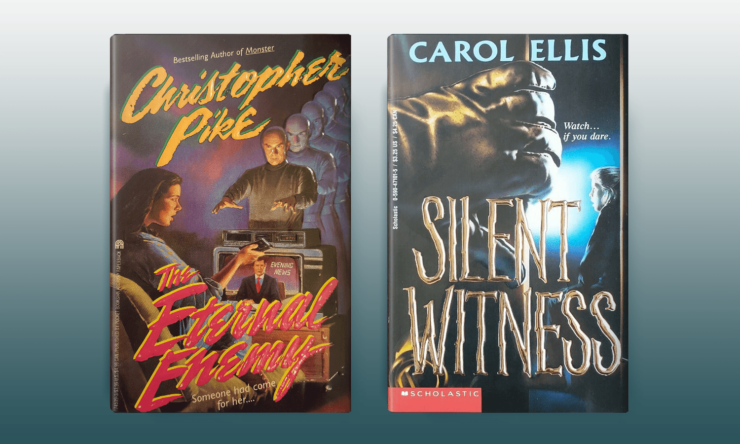I miss video stores. The thrill of picking up a long-anticipated new release, the suspense of wondering whether all the copies of the movie you want will already be rented, the endless sense of possibility in wandering aimlessly up and down the aisles in the hope of finding some wonderful, unexpected treasure. Video stores were a gold mine of entertainment, providing the opportunity to rent, watch, and rewatch an ever-evolving collection of hundreds of movies, all for just a few dollars, and conveniently located down the street. We now have access to an even wider range of movies, even more conveniently, streaming onto our screens without ever having to leave the house, but it’s just not the same.
Video cassettes, VCRs, and the horrors of the small screen are central to Christopher Pike’s The Eternal Enemy (1993) and Carol Ellis’s Silent Witness (1994). These two books evoke different modes of horror and suspense, with science fiction in Pike and mystery/thriller in Ellis. However, in both cases, the role of video recording is central to understanding the past and the future, as well as the characters and the people around them, both friends and foes. There is also an interesting dynamic of power and agency at play, in being able to record, watch, and manipulate the images on the screen through how those are created, consumed, and mediated.
In Pike’s The Eternal Enemy, Rela really wants a VCR. She’s on a pretty tight budget, but Ed at Circuit City helps her out, upselling her on a pricier VCR, then letting her pay what she can and write a post-dated check for the difference. (Ed is probably NOT employee of the month material. He’s also a bit creepy: Rela tells him she’s having a party and when he hits on her and asks for an invite, she tells him no. But he has her check, which means he has her address, and he shows up at the party anyway. Rela shrugs this off and sets him up with her best friend Stacy. Everyone is cool with this, and Ed and Stacy are making out in no time). Rela runs home with her VCR and gets it set up in her room, excited to get recording as she sets it to tape an old horror movie that’s running on cable in the wee hours of the morning, which she plans to make the feature presentation of a party she’s having later in the week. But when Rela presses play for her gathered friends, all she has recorded is a boring old news broadcast.
Buy the Book


Camp Damascus
Playing around with the VCR after the party has wrapped up, trying to figure out what she did wrong, Rela discovers that she had the date set wrong and inexplicably recorded a news broadcast from the future. She plays around with this ability a bit, cashing in through some sports betting and saving the life of a window washer who would have otherwise fallen to her death. But then Rela sees a news report of her own murder and things quickly get complicated.
As Rela continues investigating the mysterious powers of this VCR and the glimpses of possible futures it provides, she ends up finding out more about herself than she ever imagined, and the real question isn’t how does the VCR do what it does, but rather, who is Rela, how did she get here, and what’s going to happen to the human race. Rela is pretty reticent in answering questions about who she is and where came from throughout The Eternal Enemy, with pieces falling into place one at a time over the course of the novel. She lives in Los Angeles with her foster father, who works at a mission caring for those in need; she claims to remember nothing about her biological family and says she doesn’t have any idea where they are, and if anyone thinks that’s odd or pushes her for more information, she either tells them that it’s a long story or that she doesn’t want to talk about it, effectively shutting down the conversation either way. When her foster father suggests that they look harder for her family, she tells him to drop it. As her memories slowly return and more of her story comes to light, readers find out that Rela met her foster father when she came into his mission, after being found wandering the streets lost and disoriented, and he just took her home with him (which doesn’t sound at all creepy or potentially predatory, of course).
As more of Rela’s complicated story is revealed and more of her memories return, her reluctance to share her story starts to make more sense, because how can she logically explain to her friends that she’s a cyborg sent back from the future to stop an inventor from putting a chain of events into action that will eventually doom humanity? Or that her boyfriend Christopher is actually a younger version of her grandfather, the inventor she has come back in time to stop? That really does seem like the kind of thing best kept to oneself.
As Rela watches the newscasts from the future, she begins to uncover more of her own memories and mission. She has largely forgotten both who she was before (Sara) and the trauma of being transformed into a cyborg after her human death, though these realities begin to reassert themselves in unsettling, fragmentary nightmares. It’s not so much the VCR that has supernatural powers, but rather the influence Rela/Sara is able to exert on it, touching the machine and imprinting it with her own knowledge of the future, transmitted through those recorded news broadcasts. Rela/Sara is the only one who can tell herself the whole story, though she has to unearth it within herself before she is able to do so. Once she has discovered this power, she is also able to record her story, establishing the legacy she will leave behind, which will hopefully alter the course of Christopher’s life and change the path of humanity’s future.
In Pike’s final pages, readers are left wondering. Rela/Sara has sacrificed herself for the good of humanity and Christopher has watched the tape she has left behind, a narrative which loops readers back to the book’s opening lines (a circular narrative technique Pike also uses in The Immortal). Christopher has seen who he will become and the impact he will have on the world and refuses both, telling himself “I will never become that thing … Never” (180). But as he told Rela/Sara repeatedly in their conversations—both when she was a living girl in their future timeline and in their time-traveling reunion in the novel’s present moment—her grandfather thought he was doing the right thing, alleviating suffering, and acting in the best interests of the human race. At some point in the future, Christopher might find himself making that same rationalization, or forgetting the promise he has made, or simply losing his conviction for restraint when he fully grasps the knowledge and power he holds, a hubris that could drive both exploration and destruction.
Ellis’s Silent Witness is a much more conventional thriller. There’s no time travel or cyborgs, though basic questions about the state of humanity and what people are capable of remain at the heart of the story. In the book’s opening pages, Lucy Monroe is trying to come to terms with the death of her friend and neighbor Allen Torrance, who fell off “a high, crumbling, cement embankment” (2), a slightly industrialized variation of the cliffs that are so predominant in ‘90s teen horror and from which people are so frequently falling (or being pushed). Allen’s grieving mother gives Lucy a box of Allen’s belongings that she thinks some of his friends might like to have to remember him by, including a mysterious videotape.
Allen was an aspiring filmmaker, frequently taking his video recorder with him and chronicling his and his friends’ everyday lives, including the senior class car wash and a recent party. But there’s something special about this particular tape, because as soon as people know that Lucy has it, someone starts trying really hard to get it from her. This mysterious someone goes through her locker and breaks into her house, attacks her best friend Jenny when they mistake Jenny for Lucy, and locks Lucy in an air-tight closet in the school’s video editing lab, hoping she’ll suffocate and die undetected in there over the long weekend.
Suddenly, almost every one of Lucy’s friends is a suspect: there’s Suzanne, who has been dating Brad for years, but was caught on the tape making out with another guy. There’s Jon, a cute new boy that Lucy’s interested in, whose dark side is captured on the tape as he angrily confronts Allen and pushes the camera away.
But in the end, Robert is the one with the most to hide and a secret to kill for: at the head of the class and elite-college-bound, he stands to lose it all if anyone sees Allen’s tape, which shows Robert fleeing the scene of a fatal hit and run accident. Allen encouraged Robert to go to the police and tell them what happened–Robert was admittedly driving too fast, but the guy he hit was drunkenly walking down the middle of a deserted road. However, Robert refuses, not willing to risk his bright future over what he sees as a mistake best put behind him and forgotten about. When Allen threatens to take his tape to the police if Robert doesn’t come forward himself, Robert kills Allen. The hit and run was an accident, but when he kills Allen to keep him silent, it is murder, and Robert quickly finds himself in a situation where he’ll have to keep killing if he wants to keep his secret, as he attacks Jenny and tries to kill Lucy multiple times in his quest to get the tape back (though Lucy survives through quick thinking, locking Robert in the same air-tight closet in which he trapped her).
In both The Eternal Enemy and Silent Witness, these unconventional videos allow the books’ protagonists to speak from beyond the grave, to intervene in the world as it continues on, and to change the course of events moving forward. Christopher watches Rela/Sara’s story and, armed with this insight, might make better, more humane choices, while Allen’s tape is able to ensure that Robert is brought to justice, even after Allen himself has been silenced. The images recorded on these tapes and the experiences of the characters who watch them blur the lines between what is, what was, and what could one day be. The characters have a great deal of control over the tapes themselves: choosing what to record, what stories to leave behind, fast-forwarding to the consequences of Christopher’s actions or rewinding to a world where Allen was still alive. But in the end, the images on the screen are just that: images, flickering and dynamic but untouchable, immutable. The surviving characters of The Eternal Enemy and Silent Witness are stuck with the real world, where you only get one shot and time only moves in one direction, left to make their choices, hope for the best, and see how it all plays out.
Alissa Burger is an associate professor at Culver-Stockton College in Canton, Missouri. She writes about horror, queer representation in literature and popular culture, graphic novels, and Stephen King. She loves yoga, cats, and cheese.










